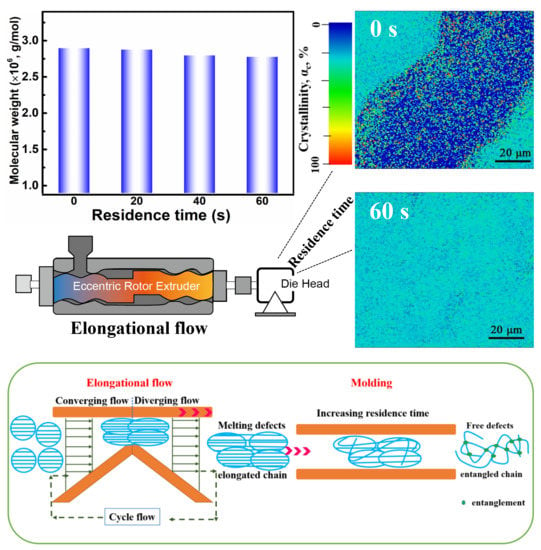Enhancing Chain Mobility of Ultrahigh Molecular Weight Polyethylene by Regulating Residence Time under a Consecutive Elongational Flow for Improved Processability
Abstract
:1. Introduction
2. Materials and Methods
2.1. Sample Preparation
2.2. Characterization
3. Results and Discussions
3.1. Morphology
3.2. Raman Mapping
3.3. Polarized Raman Spectra
3.4. Chain Diffusion
3.5. Molecular Weight
3.6. Diffused Mechanism Discussion
4. Conclusions
Supplementary Materials
Author Contributions
Funding
Institutional Review Board Statement
Informed Consent Statement
Data Availability Statement
Acknowledgments
Conflicts of Interest
References
- Samad, M.A. Recent Advances in UHMWPE/UHMWPE Nanocomposite/UHMWPE Hybrid Nanocomposite Polymer Coatings for Tribological Applications: A Comprehensive Review. Polymers 2021, 13, 608. [Google Scholar] [CrossRef]
- Pezzotti, G. Raman spectroscopy of biomedical polyethylenes. Acta Biomater. 2017, 55, 28–99. [Google Scholar] [CrossRef] [PubMed]
- Chhetri, S.; Bougherara, H. A comprehensive review on surface modification of UHMWPE fiber and interfacial properties. Compos. Part A Appl. Sci. Manuf. 2021, 140, 106146–106171. [Google Scholar] [CrossRef]
- Patel, K.; Chikkali, S.H.; Sivaram, S. Ultrahigh molecular weight polyethylene: Catalysis, structure, properties, processing and applications. Prog. Polym. Sci. 2020, 109, 101290. [Google Scholar] [CrossRef]
- Shen, H.W.; He, L.; Fan, C.H.; Xie, B.H.; Yang, W.; Yang, M.B. Improving the integration of HDPE/UHMWPE blends by high temperature melting and subsequent shear. Mater. Lett. 2015, 138, 247–250. [Google Scholar] [CrossRef]
- Huang, Z.X.; Qu, J.P. Structural and properties evolution of immiscible polypropylene/polyethylene blended under elongational flow. Polym. Mater. Sci. Eng. 2021, 37, 8–15. [Google Scholar]
- Wimmer, F.P.; Ebel, V.; Schmidt, F.; Mecking, S. Compartmentalized polymerization in aqueous and organic media to low-entangled ultra high molecular weight polyethylene. Polym. Chem. 2021, 12, 3116–3123. [Google Scholar] [CrossRef]
- Jauffres, D.; Lame, O.; Vigier, G.; Doré, F. Microstructural origin of physical and mechanical properties of ultra high molecular weight polyethylene processed by high velocity compaction. Polymers 2007, 48, 6374–6383. [Google Scholar] [CrossRef]
- Doucet, N.; Lame, O.; Vigier, G.; Dore, F.; Seguela, R. Sintering kinetics of UHMWPE nascent powders by high velocity compaction: Influence of molecular weight. Eur. Polym. J. 2013, 49, 1654–1661. [Google Scholar] [CrossRef]
- Cao, C.L.; Chen, X.C.; Wang, J.X.; Lin, Y.; Guo, Y.Y.; Qian, Q.R.; Chen, Q.H.; Feng, Y.H.; Yu, D.S.; Chen, X.D. Structure and properties of ultrahigh molecular weight polyethylene processed under a consecutive elongational flow. J. Polym. Res. 2017, 25, 16–25. [Google Scholar] [CrossRef]
- Ito, A.; Hioki, K.; Kono, K.; Hiejima, Y.; Nitta, K.H. Effects of Liquid Paraffin on Dynamic Mechanical Properties of Linear High-Density Polyethylene. Macromolecules 2020, 53, 8459–8466. [Google Scholar] [CrossRef]
- Galeski, A.; Bartczak, Z.; Vozniak, A.; Pawlak, A.; Walkenhorst, R. Morphology and plastic yielding of ultrahigh molecular weight polyethylene. Macromolecules 2020, 53, 6063–6077. [Google Scholar] [CrossRef] [PubMed]
- Deplancke, T.; Lame, O.; Rousset, F.; Aguili, I.; Seguela, R.; Vigier, G. Diffusion versus Cocrystallization of Very Long Polymer Chains at Interfaces: Experimental Study of Sintering of UHMWPE Nascent Powder. Macromolecules 2013, 47, 197–207. [Google Scholar] [CrossRef]
- Jauffres, D.; Lame, O.; Vigier, G.; Doré, F. How Nascent Structure of Semicrystalline Polymer Powders Enhances Bulk Mechanical Properties. Macromolecules 2008, 41, 9793–9801. [Google Scholar] [CrossRef]
- Taddei, P.; Di Foggia, M.; Affatato, S. Raman characterisation of conventional and cross-linked polyethylene in acetabular cups run on a hip joint simulator. J. Raman Spectrosc. 2011, 42, 1344–1352. [Google Scholar] [CrossRef]
- Wang, M.F.; Vantasin, S.; Wang, J.P.; Sato, H.; Zhang, J.M.; Ozaki, Y. Distribution of Polymorphic Crystals in the Ring-Banded Spherulites of Poly(butylene adipate) Studied Using High-Resolution Raman Imaging. Macromolecules 2017, 50, 3377–3387. [Google Scholar] [CrossRef]
- Ma, L.; Zhou, Z.Z.; Zhang, J.; Sun, X.L.; Li, H.H.; Zhang, J.M.; Yan, S.K. Temperature-dependent recrystallization morphologies of carbon-coated isotactic polypropylene highly oriented thin films. Macromolecules 2017, 50, 3582–3589. [Google Scholar] [CrossRef]
- Jaggi, H.S.; Satapathy, B.K.; Ray, A.R. Viscoelastic properties correlations to morphological and mechanical response of HDPE/UHMWPE blends. J. Polym. Res. 2014, 21, 1–13. [Google Scholar] [CrossRef]
- Yang, H.; Hui, L.; Zhang, J.; Chen, P.; Li, W. Effect of entangled state of nascent uhmwpe on structural and mechanical properties of HDPE/UHMWPE blends. J. Appl. Polym. Sci. 2017, 134, 44728–44736. [Google Scholar] [CrossRef]
- Christakopoulos, F.; Bersenev, E.; Grigorian, S.; Brem, A.; Ivanov, D.A.; Tervoort, T.A.; Litvinov, V. Melting-Induced Evolution of Morphology, Entanglement Density, and Ultradrawability of Solution-Crystallized Ultrahigh-Molecular-Weight Polyethylene. Macromolecules 2021, 54, 5683–5693. [Google Scholar] [CrossRef]
- Zhang, X.; Zhao, S.C.; Xin, Z. The chain dis-entanglement effect of polyhedral oligomeric silsesquioxanes (POSS) on ultra-high molecular weight polyethylene (UHMWPE). Polymers 2020, 202, 122631. [Google Scholar] [CrossRef]
- Danilova, S.N.; Yarusova, S.B.; Kulchin, Y.N.; Zhevtun, I.G.; Buravlev, I.Y.; Okhlopkova, A.A.; Gordienko, P.S.; Subbotin, E.P. UHMWPE/CaSiO3 Nanocomposite: Mechanical and Tribological Properties. Polymers 2021, 13, 570. [Google Scholar] [CrossRef]
- Karatrantos, A.; Composto, R.J.; Winey, K.I.; Kröger, M.; Clarke, N. Modeling of Entangled Polymer Diffusion in Melts and Nanocomposites: A Review. Polymers 2019, 11, 876. [Google Scholar] [CrossRef] [PubMed] [Green Version]
- Deplancke, T.; Lame, O.; Rousset, F.; Seguela, R.; Vigier, G. Mechanisms of Chain Reentanglement during the Sintering of UHMWPE Nascent Powder: Effect of Molecular Weight. Macromolecules 2015, 48, 5328–5338. [Google Scholar] [CrossRef]






Publisher’s Note: MDPI stays neutral with regard to jurisdictional claims in published maps and institutional affiliations. |
© 2021 by the authors. Licensee MDPI, Basel, Switzerland. This article is an open access article distributed under the terms and conditions of the Creative Commons Attribution (CC BY) license (https://creativecommons.org/licenses/by/4.0/).
Share and Cite
Chen, X.; Wang, X.; Feng, Y.; Qu, J.; Yu, D.; Cao, C.; Chen, X. Enhancing Chain Mobility of Ultrahigh Molecular Weight Polyethylene by Regulating Residence Time under a Consecutive Elongational Flow for Improved Processability. Polymers 2021, 13, 2192. https://0-doi-org.brum.beds.ac.uk/10.3390/polym13132192
Chen X, Wang X, Feng Y, Qu J, Yu D, Cao C, Chen X. Enhancing Chain Mobility of Ultrahigh Molecular Weight Polyethylene by Regulating Residence Time under a Consecutive Elongational Flow for Improved Processability. Polymers. 2021; 13(13):2192. https://0-doi-org.brum.beds.ac.uk/10.3390/polym13132192
Chicago/Turabian StyleChen, Xiaochuan, Xiaotong Wang, Yanhong Feng, Jinping Qu, Dingshan Yu, Changlin Cao, and Xudong Chen. 2021. "Enhancing Chain Mobility of Ultrahigh Molecular Weight Polyethylene by Regulating Residence Time under a Consecutive Elongational Flow for Improved Processability" Polymers 13, no. 13: 2192. https://0-doi-org.brum.beds.ac.uk/10.3390/polym13132192






